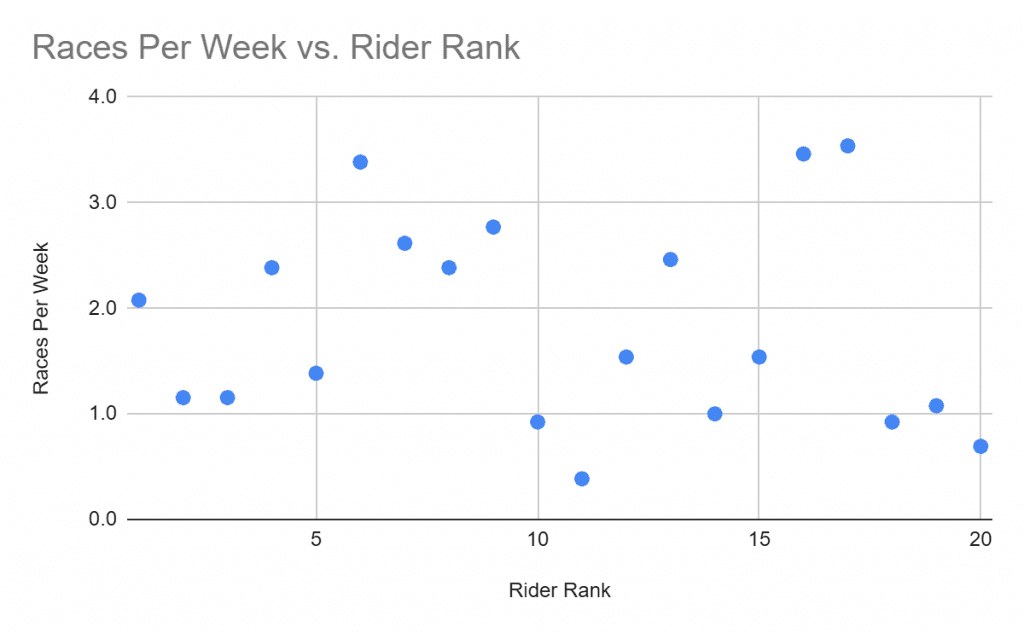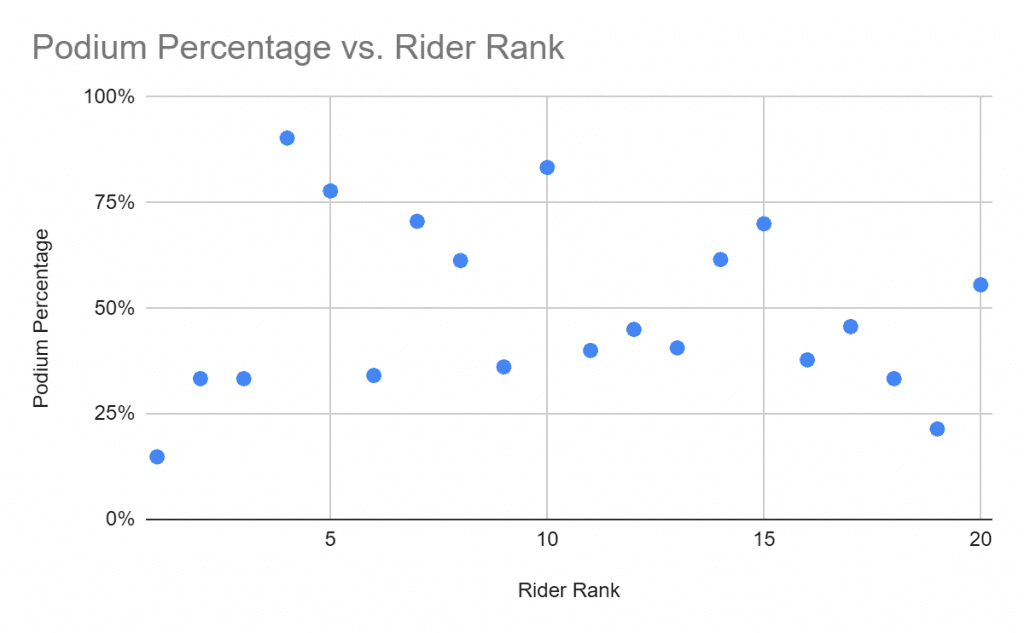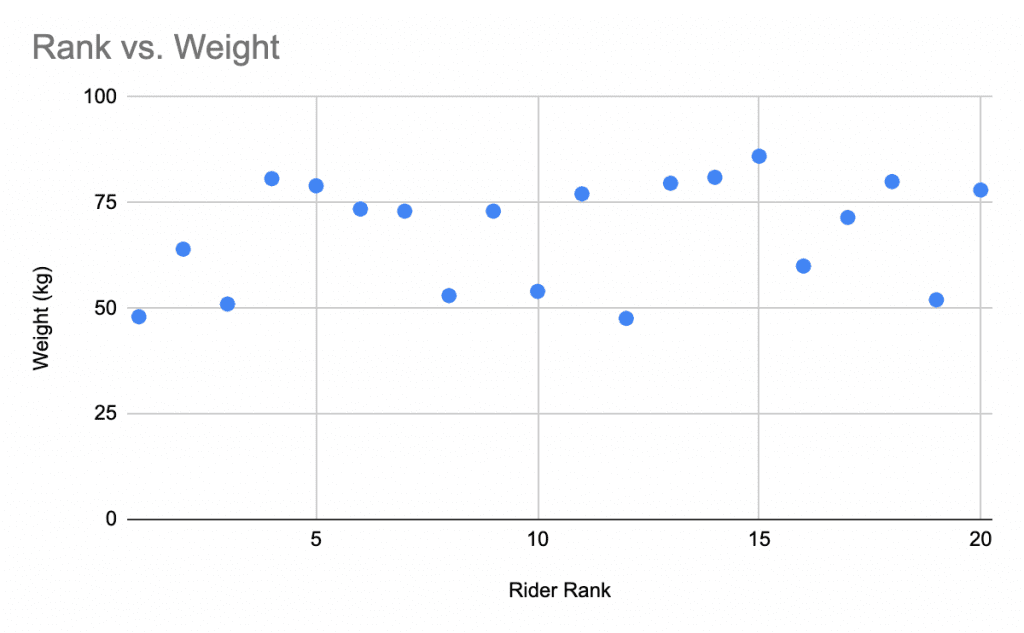I had been riding off and on since I had kids about 8 years ago. Two years ago, I found out about Zwift and was immediately hooked. I was determined to be the top Category A+ racer. I was a Division I runner in college and I figured “how hard can it be to beat these people?” Of course I am old, I have two kids and a full time job and I really wasn’t a very good Division I runner, so I quickly pivoted to “What does it take to be the top CATEGORY B racer?”. Below is what I found after cranking through the data.
If you don’t know about ZwiftPower and how they rank races, check out the top 20 riders in Cat B, which I used as a basis for analysis. (Only race data considered; group rides and tours were excluded in the analysis.)
After analyzing the data, it is clear that if you’re looking to move into the top positions, you should try to emulate the below:
- Race Experience: These people race a lot and get very good at it. Zwift is a skill. It also gives them more chances to pray to the powerup gods.
- Pretty High 15-Second Sprint Power: 10+ W/kg
- Very High 1-Minute Power: 6.5+ W/kg (most likely the 45 seconds before the sprint, then 10+ W/kg at the end; you have to be able to get into a position to let your 10+ W/kg sprint rip)
- Top of Category 20-Minute Power: 3.7 to 4.9 W/kg; overall average 4.1 W/kg
- Be Light: ZwiftPower states that to move to Cat A you have to have three races/group rides above 4.0 W/kg 20-Minute Power and your power from those rides must be above 250 Watts. So if you are light you can exceed 4.0 W/kg and remain in Cat B.
- Race in Category A: Higher Category = lower points
If you’re curious about the specific data I used, check out all the data details at the end of the article. Otherwise, let’s jump into the number details.
The Numbers Breakdown
So let’s start here… the data table:

20-Minute Power
This one isn’t a mystery. You must have a high power to weight ratio. All of these riders except one are capable of riding 45-60 minute races at 4.0 W/kg or above (except that pesky Rider 11). They may not do it every race, but they can, and I am guessing they are all experts at sitting in the draft.
Six of the 20 riders have W/kg that averaged over 4.0 W/kg. That is because they are small enough not to trigger the category upgrade where you need to be above a 250 W FTP.
5-Minute Power
You need to be able to hang with the group up the hills. About 4.7 W/kg will do the trick on average. I did some spot checks on races and that is about right, except for the light people who average higher. Hopefully, I will be able to figure out a better way to get actual data for individual races and I can expand on this.
1-Minute Power
I think this is the most important part of placing highly. As you can see in the table above, you have to be very good at 1-Minute power. If you can’t average 6.5 – 7.0 W/kg across the final minute of the race you won’t even be in a position to use your sprint. This is skewed up because it likely includes the 15-second sprint power – to correct for this I extrapolated 45-Second power in the table.
Or more succinctly: you have to sprint for 45 seconds at the 45-second power and then 15 seconds at the 15-second power.
15-Second Power
My initial hypothesis was that the person with the max 15-second power was going to win the race. This is partially true, but it seems like a combination of 1-minute and 15-second is the key. You have to be good at both. As you can see in the table, you need to be able to average at least 10 W/kg, and realistically 11 W/kg to get into this upper echelon of B category racers. If you want to be the top B racer you need 12 W/kg to hang with the sprint in the A category where you need to race to get a low enough ranking.
Races Per Week
If you want to get a good rank you have to race a lot. Don’t underestimate the power of learning how to race well and the luck of needing an aero to place high enough to get that race ranking.

Podium Percentage
This is how often a racer is in the top three of their race. Lots of these people race in the A category so their ranking gets better while still classified as a B rider. In general, the lower podium percentage racers here usually race in Cat A, and the higher percentages race more in B. I was surprised the percentages were not higher – it might go to show how hard it is to get in position and have the right powerup for a Zwift sprint.

Other Tidbits
- The racers seem to be clustered around 50 and 75 kg.
- The lighter side makes sense – they can exceed Cat B W/kg with an FTP right below 250. They must be just heavy enough where the flats aren’t too bad and the sprints are fast too. It also might just be the lower limit of what men (I believe these are all men) weigh – I found a calculator that said 50 kg was in the 1st percentile of 30-year-old men.
- I’m not sure why 75 kg. I’m guessing it provides enough strength for a good sprint with a low enough weight to keep a reasonable FTP for normal people. This might also just be the weight most men end up around when they are biking a lot.
- 11 of the 20 riders race primarily in Cat A, 4 of the riders race in a combo of A and B, and the other 5 riders primarily race B.
- 5 of the 20 riders have fake names.
- 1 of the riders (Tom Gakes) looks like he used to be a pro and is a verified rider on ZwiftPower.
- 3 of the 20 riders are under 20 years old, 2 are between 23-29, 11 are between 30-39, 2 are between 40-49. 1 person is not registered at ZwiftPower (I don’t get why the person is in there). 1 person mysteriously disappeared from ZwiftPower since I ran the data and 3 days later when I looked up the ages.
- 6 of the people are from Europe, 5 are from North America, 8 are from Asia and one has vanished into the ether. Japan and the US are tied with 4 each.
- A huge portion of the races these people do are short and flat like Crits.
The Data Details
- Data Source: ZwiftPower
- Data Curation: Manually downloaded. I would love to pull more data and do other analyses (see other articles I’m planning at the end) but I haven’t found an API to download all of the data from ZwiftPower. (Guys who run ZwiftPower – hit me up.)
- Data Filter(s): Past 90 days of racing from the Top 20 category B racers as of July 26th. When you look at the rider profiles you will see higher power than what is shown below because the data I used is only from races where the rider achieved a rank of under 250 for the race ranking. Our goal is to identify how to become a top Category B racer in Zwift, not to see what everyone’s max wattage is during a 2.0 W/kg group ride with a sprint in the middle. Also, cutting off at 250 is arbitrary. Looking at the best five races from some of the riders between 15-20th it looked like a good cutoff.
- Analysis Tool(s): Google Sheets and Excel. If I can get more data I will do better analysis in R, but this data is easy.
- Additional Notes: Rider 11 seems to be an anomaly. That person has consistently lower power across all categories.
Let Me Know What Else You’d Like to Know About
Below are additional data-focused articles I plan to write, also based on data from ZwiftPower:
- Cat A+, A, C, D (Next in Line)
- Women Specific article – I’m not sure of format and Categories
- What it takes to win a Zwift race
- How to win on each course
- Zwift Rankings and Category Improvements
Let me know if this has helped you and what you want to hear about next. Just keep in mind that I cry easily and if I don’t see any comments or votes below that my kids will ask me why I am sobbing at my computer looking at Zwift Insider and I will have to explain how cruel a place the world is. So please just comment so I don’t have to burst my kids’ bubbles at 6 and 8 years old.
